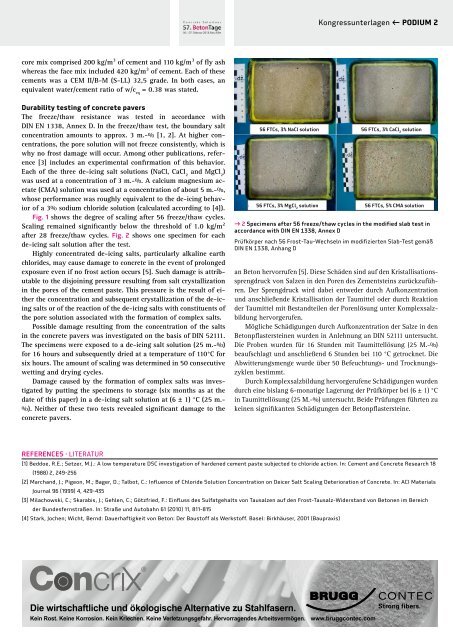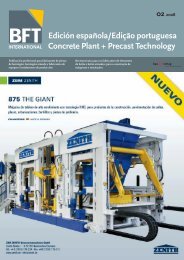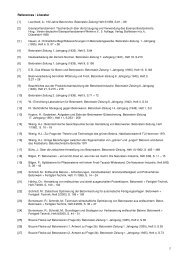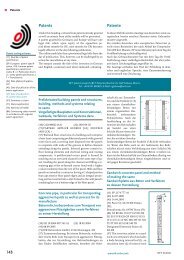KONGRESSUNTERLAGEN | PROCEEDINGS - Bft-international.com
KONGRESSUNTERLAGEN | PROCEEDINGS - Bft-international.com
KONGRESSUNTERLAGEN | PROCEEDINGS - Bft-international.com
Erfolgreiche ePaper selbst erstellen
Machen Sie aus Ihren PDF Publikationen ein blätterbares Flipbook mit unserer einzigartigen Google optimierten e-Paper Software.
Kongressunterlagen ← PODIUM 2<br />
core mix <strong>com</strong>prised 200 kg/m³ of cement and 110 kg/m³ of fly ash<br />
whereas the face mix included 420 kg/m³ of cement. Each of these<br />
cements was a CEM II/B-M (S-LL) 32,5 grade. In both cases, an<br />
equivalent water/cement ratio of w/c eq<br />
= 0.38 was stated.<br />
Durability testing of concrete pavers<br />
The freeze/thaw resistance was tested in accordance with<br />
DIN EN 1338, Annex D. In the freeze/thaw test, the boundary salt<br />
concentration amounts to approx. 3 m.-% [1, 2]. At higher concentrations,<br />
the pore solution will not freeze consistently, which is<br />
why no frost damage will occur. Among other publications, reference<br />
[3] includes an experimental confirmation of this behavior.<br />
Each of the three de-icing salt solutions (NaCl, CaCl 2<br />
and MgCl 2<br />
)<br />
was used at a concentration of 3 m.-%. A calcium magnesium acetate<br />
(CMA) solution was used at a concentration of about 5 m.-%,<br />
whose performance was roughly equivalent to the de-icing behavior<br />
of a 3% sodium chloride solution (calculated according to [4]).<br />
Fig. 1 shows the degree of scaling after 56 freeze/thaw cycles.<br />
Scaling remained significantly below the threshold of 1.0 kg/m²<br />
after 28 freeze/thaw cycles. Fig. 2 shows one specimen for each<br />
de-icing salt solution after the test.<br />
Highly concentrated de-icing salts, particularly alkaline earth<br />
chlorides, may cause damage to concrete in the event of prolonged<br />
exposure even if no frost action occurs [5]. Such damage is attributable<br />
to the disjoining pressure resulting from salt crystallization<br />
in the pores of the cement paste. This pressure is the result of either<br />
the concentration and subsequent crystallization of the de-icing<br />
salts or of the reaction of the de-icing salts with constituents of<br />
the pore solution associated with the formation of <strong>com</strong>plex salts.<br />
Possible damage resulting from the concentration of the salts<br />
in the concrete pavers was investigated on the basis of DIN 52111.<br />
The specimens were exposed to a de-icing salt solution (25 m.-%)<br />
for 16 hours and subsequently dried at a temperature of 110°C for<br />
six hours. The amount of scaling was determined in 50 consecutive<br />
wetting and drying cycles.<br />
Damage caused by the formation of <strong>com</strong>plex salts was investigated<br />
by putting the specimens to storage (six months as at the<br />
date of this paper) in a de-icing salt solution at (6 ± 1) °C (25 m.-<br />
%). Neither of these two tests revealed significant damage to the<br />
concrete pavers.<br />
56 FTCs, 3% NaCl solution 56 FTCs, 3% CaCl 2<br />
solution<br />
56 FTCs, 3% MgCl 2<br />
solution 56 FTCs, 5% CMA solution<br />
→ 2 Specimens after 56 freeze/thaw cycles in the modified slab test in<br />
accordance with DIN EN 1338, Annex D<br />
Prüfkörper nach 56 Frost-Tau-Wechseln im modifizierten Slab-Test gemäß<br />
DIN EN 1338, Anhang D<br />
an Beton hervorrufen [5]. Diese Schäden sind auf den Kristallisationssprengdruck<br />
von Salzen in den Poren des Zementsteins zurückzuführen.<br />
Der Sprengdruck wird dabei entweder durch Aufkonzentration<br />
und anschließende Kristallisation der Taumittel oder durch Reaktion<br />
der Taumittel mit Bestandteilen der Porenlösung unter Komplexsalzbildung<br />
hervorgerufen.<br />
Mögliche Schädigungen durch Aufkonzentration der Salze in den<br />
Betonpflastersteinen wurden in Anlehnung an DIN 52111 untersucht.<br />
Die Proben wurden für 16 Stunden mit Taumittellösung (25 M.-%)<br />
beaufschlagt und anschließend 6 Stunden bei 110 °C getrocknet. Die<br />
Abwitterungsmenge wurde über 50 Befeuchtungs- und Trocknungszyklen<br />
bestimmt.<br />
Durch Komplexsalzbildung hervorgerufene Schädigungen wurden<br />
durch eine bislang 6-monatige Lagerung der Prüfkörper bei (6 ± 1) °C<br />
in Taumittellösung (25 M.-%) untersucht. Beide Prüfungen führten zu<br />
keinen signifikanten Schädigungen der Betonpflastersteine.<br />
REFERENCES · LITERATUR<br />
[1] Beddoe, R.E.; Setzer, M.J.: A low temperature DSC investigation of hardened cement paste subjected to chloride action. In: Cement and Concrete Research 18<br />
(1988) 2, 249-256<br />
[2] Marchand, J.; Pigeon, M.; Bager, D.; Talbot, C.: Influence of Chloride Solution Concentration on Deicer Salt Scaling Deterioration of Concrete. In: ACI Materials<br />
Journal 96 (1999) 4, 429-435<br />
[3] Milachowski, C.; Skarabis, J.; Gehlen, C.; Götzfried, F.: Einfluss des Sulfatgehalts von Tausalzen auf den Frost-Tausalz-Widerstand von Betonen im Bereich<br />
der Bundesfernstraßen. In: Straße und Autobahn 61 (2010) 11, 811-815<br />
[4] Stark, Jochen; Wicht, Bernd: Dauerhaftigkeit von Beton: Der Baustoff als Werkstoff. Basel: Birkhäuser, 2001 (Baupraxis)<br />
Die wirtschaftliche und ökologische Alternative zu Stahlfasern.<br />
Kein Rost. Keine Korrosion. Kein Kriechen. Keine Verletzungsgefahr. Hervorragendes Arbeitsvermögen.<br />
www.bruggcontec.<strong>com</strong>












